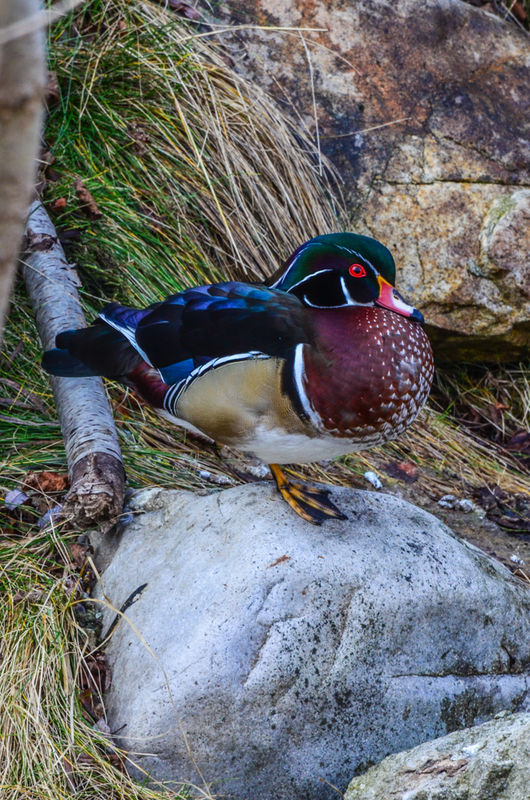DX "Reach" versus magnification
Feb 3, 2013 08:32:30 #
Still pretty new to this and thought I understood it.
You get less of a field of view with the DX than the FF. If you use the DX and either back up or decrease the length on a zoom, wouldn't you get the same composition?
You get less of a field of view with the DX than the FF. If you use the DX and either back up or decrease the length on a zoom, wouldn't you get the same composition?
Feb 3, 2013 08:46:21 #
Finch585 wrote:
Can anyone please explain in simple terms the difference between the DX "reach" (compared to FX) versus image magnification?
I'm guessing the increased reach of the DX crop sensor on any given focal length lens is not really the same as increasing magnification, or is it in regards to the end result of an image?
Thanks in advance,
Jeffrey
I'm guessing the increased reach of the DX crop sensor on any given focal length lens is not really the same as increasing magnification, or is it in regards to the end result of an image?
Thanks in advance,
Jeffrey
This Lens Simulator is good.
http://imaging.nikon.com/lineup/lens/simulator/
Feb 3, 2013 11:11:40 #
BboH wrote:
Whatever - fact is I used my Nikon 70-300 AF-S on ... (show quote)
Very good. We've had this discussion on uhh a few times before but the last time I saw it, the D800 was in the planning stage. This information would be more useful if you would take it a bit further and state, for those who do not know, the difference in megapixels of these two shots and then if you would go a step further and crop the FX image identical to the DX image and then check for the megapixel count, magnify both images and see which one pixelates first and reveal how many steps up in magnification you had to go to reach that same pixelation point with both images, first the uncropped FX image, then the other two which should be very close in size and quality. We've done it with the 5D2 and 7D and others but not the same camera, same lens, same sensor, etc., which would seem to yield more identical results in both modes, not similar, but identical off the same sensor. Please, and thank you.
Feb 3, 2013 11:44:55 #
St3v3M wrote:
Cut a 12 inch hole out of a piece of paper and look through it. (Full Frame)
Now cut a hole 8 inch (1.5 times smaller) and look through it. (Crop Sensor)
Where you see the 'full' image through the first, you see a 'cropped' version in the second.
Now cut a hole 8 inch (1.5 times smaller) and look through it. (Crop Sensor)
Where you see the 'full' image through the first, you see a 'cropped' version in the second.
So simple. So effective.
Assuming increasing the focal length is like moving the hole closer to the subject.
Feb 3, 2013 11:47:34 #
jerryc41 wrote:
This might help.
Finch585 wrote:
Can anyone please explain in simple terms the difference between the DX "reach" (compared to FX) versus image magnification?
I'm guessing the increased reach of the DX crop sensor on any given focal length lens is not really the same as increasing magnification, or is it in regards to the end result of an image?
Thanks in advance,
Jeffrey
I'm guessing the increased reach of the DX crop sensor on any given focal length lens is not really the same as increasing magnification, or is it in regards to the end result of an image?
Thanks in advance,
Jeffrey
This might help.
Nice graphic.
Feb 3, 2013 12:13:08 #
PhotoArtsLA wrote:
This is about FX and DX where FX is full frame and... (show quote)
Thank you for another reason to prefer the 28-300 FX over the 18-300 DX, even though I don't (yet) have an FX camera. One always likes to have justification for such expenditures!
Just getting started with it but think I'm gonna like it.

Feb 3, 2013 12:19:28 #
Brucej67 wrote:
Isn't that assuming you are using the same lens on the crop sensor camera as on the full frame camera? If you use a lens made for a crop sensor camera on the crop sensor camera and use a lens made for a full frame camera on the full frame camera and if both lenses have the same focal length the results should be the same for testing.
No, I don't think that's right because if I put my 35mm DX f/1.8G lens on my D7000 I thought it still provides me a 52.5mm FF equivalent FOV. I believe it's just that being for DX by design, the circle of light coming through the DX lens is reduced to fit the crop sensor in full rather than being cropped, therefore the lens is made smaller and lighter, or am I wrong and the DX designed lenses are providing the full MM result? [I don't have a FF body to compare this].
Feb 3, 2013 12:21:42 #
Photographer Jim wrote:
br br Honestly, I wish I had understood all of t... (show quote)
It is the reason I little interest in the D600. You get only a bit over 10 MP on the DX sensor area. I shoot DX and often need to crop to zoom in further on my wildlife shots. I'd need a D800 to get more than the 16.x MP my D5100/7000 sensor delivers. For me now the D5200 with its 24MP and pretty similar noise characteristics is the best option.
For the same MP an FX sensor always has significantly better low light (noise) performance. That's why I'd like one. But my trade off at this point is skewed towards the wildlife shots that need significant cropping.
If I were mostly a landscape photographer I'd definitedly go full frame.
Feb 3, 2013 12:26:16 #
MtnMan wrote:
quote=PhotoArtsLA This is about FX and DX where F... (show quote)
So, this goes to the nexus of my question: if you took this same shot with a higher power magnification lens on FF to result in the same subject size on screen or paper, would the FF image have better fine detailing and sharpness and perhaps less pixelation problems when blown up, as this shot that just has the illusion of similar magnification from the crop sensor's "reach"?
Feb 3, 2013 12:41:01 #
Finch585 wrote:
So, this goes to the nexus of my question: if you took this same shot with a higher power magnification lens on FF to result in the same subject size on screen or paper, would the FF image have better fine detailing and sharpness and perhaps less pixelation problems when blown up, as this shot that just has the illusion of similar magnification from the crop sensor's "reach"?
So, this goes to the nexus of my question: if you took this same shot with a higher power magnification lens on FF to result in the same subject size on screen or paper, would the FF image have better fine detailing and sharpness and perhaps less pixelation problems when blown up, as this shot that just has the illusion of similar magnification from the crop sensor's "reach"?
Pixelation relates to the MP on the original image. Since the DX has more MP on the original image it can be blown up to a larger size without pixelation.
I often use it the other way: to crop more.
The wood duck shot is cropped to about 1/2 the frame and was at 300mm. You'd need a 450mm on a full frame to get the same composition. Or I'd have to crop my image with the 300mm lens down to the 45% or so representing the DX area of the image.
Even with the ISO at 500 woody required 1/30 s (f6.3). Since it was handheld I feel the clarity is a testament to the VR of the 28-300 more than anything.
Original of Woody

Feb 3, 2013 12:41:12 #
Quote:
Thanks, Jerry, that simulator is great and helps a lot.
Jeffrey
Feb 3, 2013 12:42:56 #
Feb 3, 2013 12:50:21 #
Quote:
Hey Doc ..... I don't think you get it yet ..... why don't you post the photos you're unhappy with so we can see what you're doing .....
It's actually nothing I'm unhappy about in a single image, it has to do with composition potential, and my wanting to be able to shoot the full 20mm wide and not getting only 30mm on DX without having to use a 14mm to get to 20mm (er, 21mm).
BTW, I'd love to know the reason for your affinity to the Wascaly Wabbit? He was my favorite cartoon character. Were you affiliated with the production in some manner or just a huge fan, too?
Feb 3, 2013 12:54:58 #
Finch585 wrote:
quote=Brucej67 Isn't that assuming you are using ... (show quote)
UPDATE: The Nikon lens simulator Jerry provided proves my thought, and that your idea is not true.
Feb 3, 2013 12:57:01 #
Finch585 wrote:
OK, got it, thanks
OK, got it, thanks
Here is one taken a few minutes later. It is also at 300mm and is not cropped. But here I was trying to minimize camera movement effects so upped the shutter speed to 1/500. That pushed the ISO up to 1400 so I applied Topaz denoise to reduce the noise.
Alas I see I left the EV on +1 for this but it isn't too bad (some of the hair on her nose is blown out). Some of the shots were in snow, thus the EV.

If you want to reply, then register here. Registration is free and your account is created instantly, so you can post right away.



